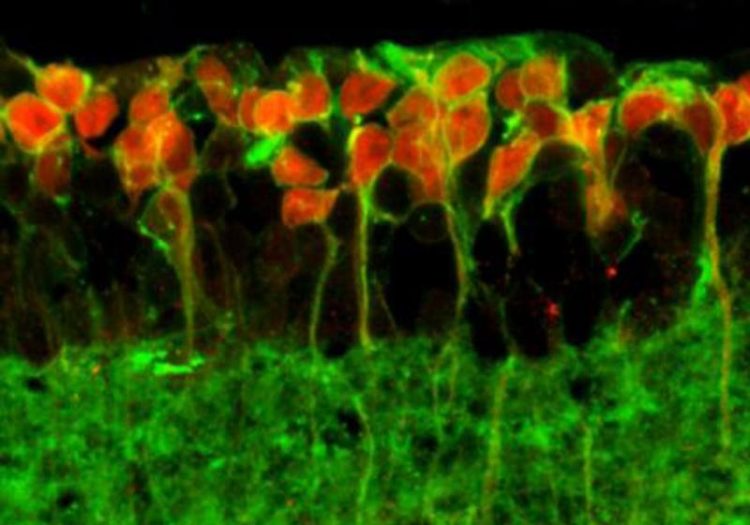Light in sight

The retina of a blind mouse treated with the new approach: A «light antenna» has been attached to the red cells. Sonja Kleinlogel
Hereditary blindness caused by a progressive degeneration of the light-sensing cells in the eye, the photoreceptors, affects millions of people worldwide. Although the light-sensing cells are lost, cells in deeper layers of the retina, which normally cannot sense light, remain intact.
Scientists from Bethe Universities of Bern, Switzerland, and Göttingen, Germany, now introduced a new light-sensing protein into the surviving retina cells, thus turning them into «replacement photoreceptors». The results were published in PLoS Biology.
«The question was: Can we design light-activatable proteins that gate specific signaling pathways in specific cells?», Dr. Sonja Kleinlogel, corresponding author of the paper whose research group is based at the University of Bern, says.
«In other words, can the natural signaling pathways of the target cells be retained and just modified in a way to be turned on by light instead of a neurotransmitter released from a preceding neuron?»
The scientists molecularly modified the cells that normally would have received direct information from the photoreceptors in a way that they reacted to light stimuli instead of chemical signals, thus turning them into replacement photoreceptors. Integrating a new «light antenna» into the surviving cells has the advantage that signal computation of the retina is maximally utilized.
«Using optical imaging of neuronal activity in the treated mice, we showed that these replacement photoreceptors were able to activate the visual cortex – the part of the cortex that analyzes visual signals – more strongly again», co-authors Prof. Dr. Siegrid Löwel and Dr. Justyna Pielecka-Fortuna, neuroscientists at the University of Göttingen, say.
The result: The mice were able to see under daylight conditions, react to visual stimuli and learn visually triggered behaviors. «The new therapy can potentially restore sight in patients suffering from any kind of photoreceptor degeneration», Dr. Kleinlogel explains.
According to her, the major improvement of the new approach is that patients should be able to see under normal daylight conditions without the need for light intensifiers or image converter goggles. «However, it will take at least another two or three years before the new light antenna can be tested in the clinical setting», she adds.
Furthermore, the novel principle opens a whole palette of new possibilities to potentially treat conditions such as pain, depression and epilepsy.
Publication details:
Van Wyk M, Pielecka-Fortuna J, Löwel S & Kleinlogel S. Restoring the ON-switch in blind retinas: Opto-mGluR6, a next-generation, cell-tailored optogenetic tool. PLoS Biology, 2015 (in press), doi/10.1371/journal.pbio.pbio.1002143
Media Contact
More Information:
http://www.unibe.chAll latest news from the category: Life Sciences and Chemistry
Articles and reports from the Life Sciences and chemistry area deal with applied and basic research into modern biology, chemistry and human medicine.
Valuable information can be found on a range of life sciences fields including bacteriology, biochemistry, bionics, bioinformatics, biophysics, biotechnology, genetics, geobotany, human biology, marine biology, microbiology, molecular biology, cellular biology, zoology, bioinorganic chemistry, microchemistry and environmental chemistry.
Newest articles

Durable, Efficient, Sustainable: The Rise of Cerium Oxide Thermal Switches
Groundbreaking cerium oxide-based thermal switches achieve remarkable performance, transforming heat flow control with sustainable and efficient technology. Cerium Oxide-Based Thermal Switches Revolutionize Heat Flow Control Thermal switches, which electrically control…

How Industrial Robots are Reducing Emissions in Global Manufacturing
A new study explores the intersection of industrial automation and environmental sustainability, focusing on the role of industrial robots in reducing the carbon intensity of manufacturing exports. The research demonstrates…

Patients Can Heal Through Precise, Personalized Bioceramic Grafts
A recent review is transforming the landscape of craniomaxillofacial bone regeneration with the introduction of personalized bioceramic grafts. This pioneering research explores the fabrication and clinical potential of synthetic grafts…



